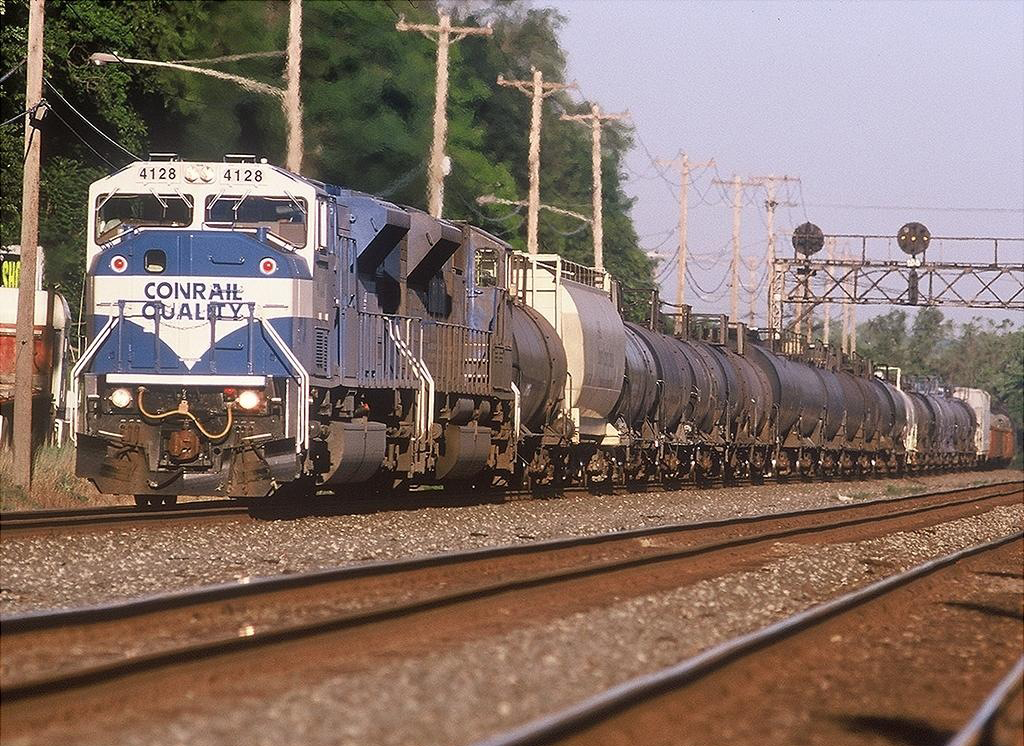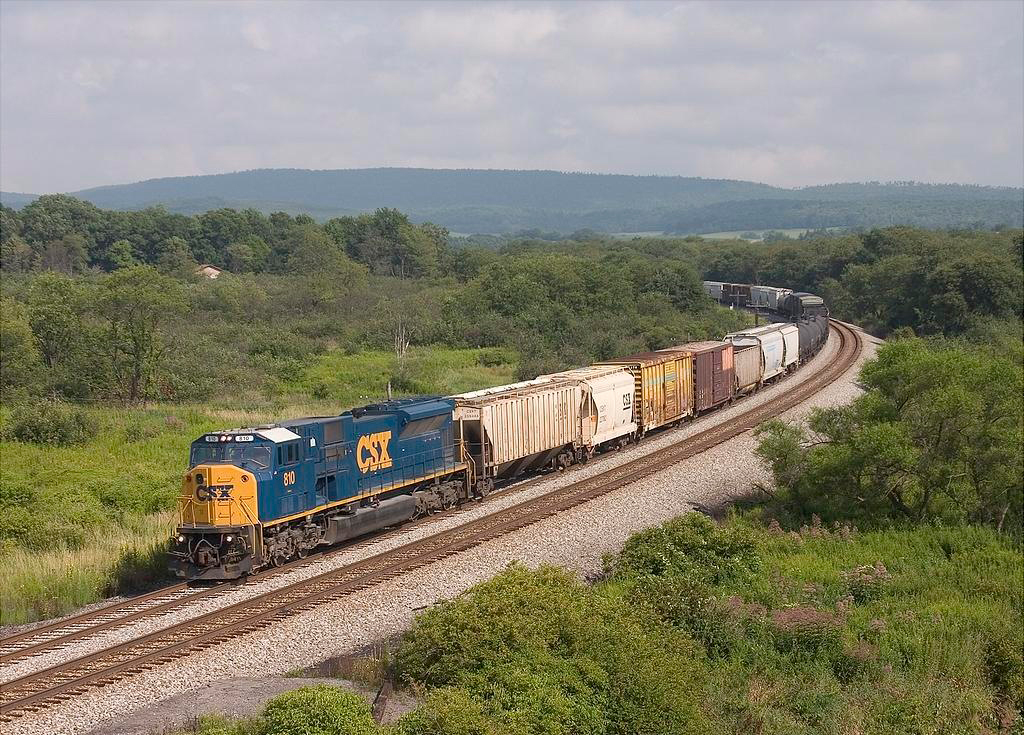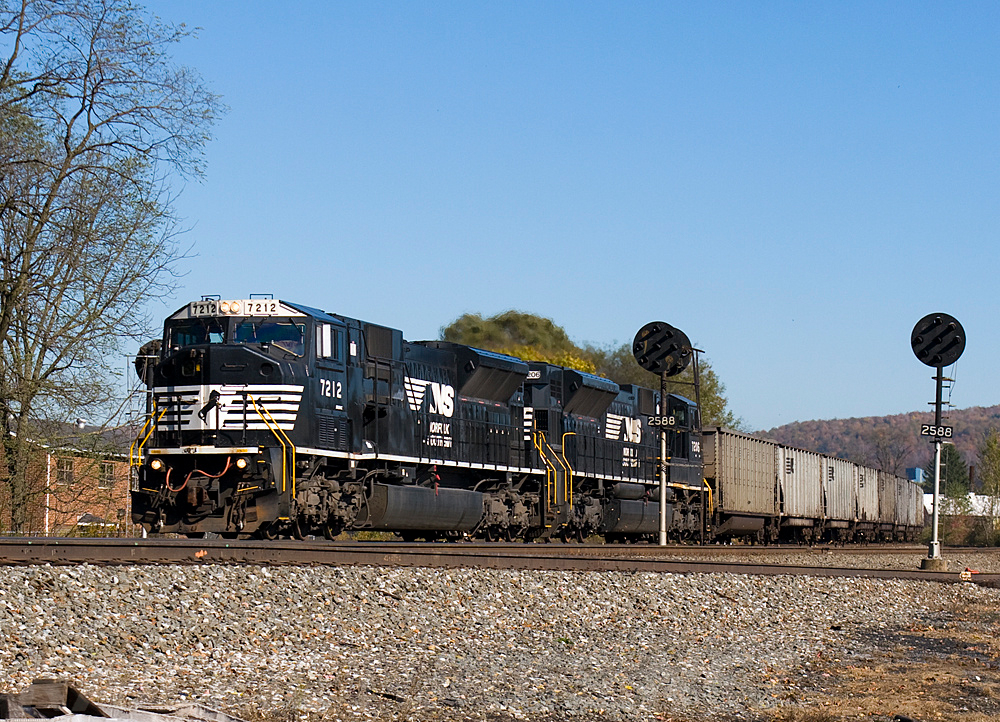EMD "SD80MAC" Locomotives: Data Sheet, Specs, Roster
Last revised: December 16, 2024
By: Adam Burns
The SD80MAC was essentially an identical
sister to the successful SD70 line except for its increased horsepower.
Much longer than any single locomotive EMD had before produced aside from its experimental DD series, the model did have some noticeable design changes from the SD70 series, aside from increased length.
The model was the first EMD locomotive to feature the flared rear radiator design that had been a common trait of General Electric diesels dating back to the 1970 and the "Dash 7" line.
While other railroads would take orders for the SD80MAC only Conrail actually purchased any units taking delivery of its fleet in the 1990s.
Railfans have come to refer the locomotives as "Conrail Cadillacs" and after the railroad was split between CSX and Norfolk Southern the units were divided between the two companies.
Today, neither CSX nor NS operate the aging '80MAC's. In 2014, the former sold its remaining twelve to the latter for twenty-three SD40-2's; six years later (February, 2020), NS sold its entire fleet to Canadian Pacific and Progress Rail.
 A pair of Conrail SD80MACs, led by #4128, have a westbound manifest on the former Pennsylvania main line at Haysville, Pennsylvania on June 22, 1997. Wade Massie photo.
A pair of Conrail SD80MACs, led by #4128, have a westbound manifest on the former Pennsylvania main line at Haysville, Pennsylvania on June 22, 1997. Wade Massie photo.Conrail
The SD80MAC is virtually identical to the SD70 series except that it is rated at 5,000 hp instead of the SD70’s 4,300 horsepower, and as mentioned above its rear flared radiator sets forward of the rear of the locomotive.
The unit is also very rare, albeit it is relatively new. Built in 1995 the SD80MAC was purchased by only one U.S. railroad, Conrail, which took delivery of 30 of them. Only 8 other SD80MACs are roaming around North America although all 38 are still in active service.
Of the 30 SD80MACs Conrail purchased, 17 went to Norfolk Southern and 13 to CSX during the split of the railroad in 1999. Eight of CSX's SD80MACs are currently off of the property and in service on Mexican carrier Ferromex.
Development
The SD80MAC's prime mover is variant of the engine used in the SD70 series, the model 710G3ES. The engine was a 20-cylinder design, the first Electro-Motive had employed in one of its locomotives since the SD45 series of the 1960s.
The SD45 actually proved to be a quite successful model for EMD despite the fact that early examples of the locomotive had reliability issues with crankshafts snapping while in operation.
Once the company was able to correct these problems by redesigning the locomotive's engine block the SD45 proved a reliable and powerful locomotive that can still be found in use all across the country today.
 CSX SD80MAC #810 leads freight Q317 westbound over the former B&O's Seventeen-Mile Grade at Oakland, Maryland on August 19, 2005. An AC4400CW is assisting from the rear. Wade Massie photo.
CSX SD80MAC #810 leads freight Q317 westbound over the former B&O's Seventeen-Mile Grade at Oakland, Maryland on August 19, 2005. An AC4400CW is assisting from the rear. Wade Massie photo.The SD80MAC did not suffer from reliability issues in terms of a problematic engine with those issues largely having been solved with the transitional SD60 line. In many ways, the model was the continuation of the high horsepower race between GE and EMD that had been ongoing since the 1970s.
This race peaked during the 1990s with the release of the SD90MAC and General Electric's AC6000CW. While GE's model sold more units than EMD's both were plagued with reliability issues which essentially ended the race between the two companies.
Additionally, railroads discovered that extremely powerful locomotives wasn't necessarily a good thing and to date, the generally accepted horsepower is somewhere between 4,000 to 4,500.
The "MAC" designation of the SD80 means two different things. The "M" regards the locomotive as featuring the now standard wide, "safety" cab that has been a common feature on motive power since the FRA mandates its use in the early 1990s.
Tractive Effort
The "AC" refers to the model featuring an alternator for increased tractive. Up to that time the SD80MAC offered some of the highest tractive efforts of any locomotive the company had produced; 185,000 pounds starting and 137,000 pounds continuous.
Interestingly, the Chicago & North Western was interested in purchasing new SD80MACs to further update its motive power fleet but was acquired by Union Pacific before being able to do so and its order was canceled.
Additionally, Conrail was after more as well until the 1999 NS/CSX split also canceled its order (the railroads replaced this with SD70 variants instead).
Data Sheet and Specifications
| Entered Production | 7/1995 (Demonstrators #8000-8001) |
| Years Produced | 7/1995 - 5/1996 |
| Engine | 710G3B-ES |
| Engine Builder | GM |
| Horsepower | 5000 |
| RPM | 950 |
| Cylinders | 20 |
| Length | 80' 2" |
| Height (Top Of Rail To Top Of Cab) | 15' 7 ½" |
| Width | 10' 3" |
| Weight | 420,000 Lbs |
| Fuel Capacity | 5000 Gallons |
| Air Compressor | Gardner-Denver |
| Air Compressor Model | WLASC |
| Air Brake Manufacturer | Westinghouse |
| Air Brake Schedule | 26L |
| Trucks | C-C |
| Truck Type | HTCR-II |
| Truck Wheelbase | 13' 7" |
| Wheel Size | 40" |
| Wheel Slip Control System | EM2000es (EMD) |
| Traction Motors | 1TB2830 (6), GM |
| Primary Generator | TA22/CA8, GM |
| Auxiliary Generator | GM (A8589) |
| Alternator | CA7A |
| MU (Multiple-Unit) | Yes |
| Dynamic Brakes | Yes |
| Gear Ratio | 70:17 |
| Tractive Effort (Starting) | 185,000 Lbs at 33% |
| Tractive Effort (Continuous) | 137,000 Lbs at 12 mph |
| Top Speed | 70 mph |
Production Roster
Total Built = 30
| Owner | Road Numbers | Serial Numbers | Completion Date |
|---|---|---|---|
| Conrail | 4100-4127 | 946501-1 thru 946501-28 | 11/1995-5/1996 |
| EMDX | 8000-8001 (became Conrail #4128-4129) | 946501-29, 946501-30 | 7/1995 |
 A pair of Norfolk Southern SD80MACs, led by #7212 lead a string of gondolas westbound on the former PRR at Portage, Pennsylvania on October 19, 2009. Wade Massie photo.
A pair of Norfolk Southern SD80MACs, led by #7212 lead a string of gondolas westbound on the former PRR at Portage, Pennsylvania on October 19, 2009. Wade Massie photo.The history of diesel locomotives has been fascinating, not only because of the many interesting designs during the last century but also their dispositions; General Electric's "Universal" series provided a foothold for the company in the market.
However, most U-boats were sold off and scrapped after barely two decades of service. This trend has seemingly continued with GE's newer models as well, such as the C40-9W, C44-9W, and AC4400CW. Newer EMD products have met a similar fate, like the SD70MAC and SD80MAC.
No designs have enjoyed the tremendous longevity of EMD's second-generation era, like the GP40, SD40 series, GP38's, SD50's, and others. You can still find these locomotives in service today, ironically having outlived newer GE and EMD models.
Sources
- Foster, Gerald. A Field Guide To Trains. New York: Houghton Mifflin, 1996.
- McDonnell, Greg. Locomotives: The Modern Diesel & Electric Reference, 2nd Edition. Buffalo: Boston Mills Press/Firefly Books, 2015.
- Solomon, Brian. American Diesel Locomotive, The. Osceola: MBI Publishing, 2000.
- Solomon, Brian. EMD Locomotives. Minneapolis: MBI Publishing Company, 2006.
- Solomon, Brian. GE and EMD Locomotives: The Illustrated History. Minneapolis: Voyageur Press, 2014.
Recent Articles
-
New Mexico Railroad Museums: A Complete Guide
Apr 23, 25 02:25 PM
The enchanting state of New Mexico, known for its vivid landscapes and rich cultural heritage, is home to a number of fascinating railroad museums. -
New Hampshire Railroad Museums: A Complete Guide
Apr 23, 25 02:11 PM
New Hampshire, known for its breathtaking landscapes, historic towns, and vibrant culture, also boasts a rich railroad history that has been meticulously preserved and celebrated across various museum… -
Minnesota Railroad Museums: A Complete Guide
Apr 22, 25 12:17 PM
The state of Minnesota has always played an important role with the railroad industry, from major cities to agriculture. Today, several museums can be found throughout the state.